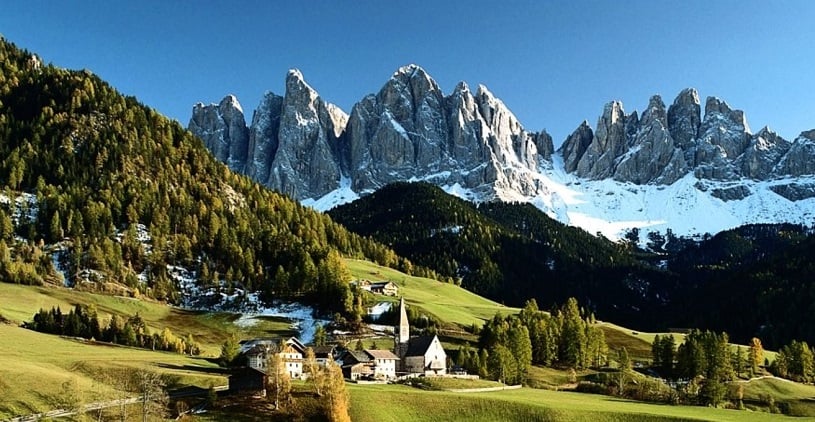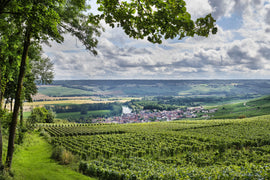TRENTINO-ALTO ADIGE/SUDTIROL
This month we’re taking it to the top, visiting Italy’s northernmost alpine region and leading source of stunning Dolomite peaks, subsequent green valleys, and befuddling nomenclature. Even the above mouthful is an abbreviation, the hyphens and slashes at once repping and yadda yadda yadda-ing centuries of tradition, turmoil, contestation and change. But it’s worth it to do the toponomastics (a real, actual word I just learned that means: the research and study of place names) when it comes to Trentino Alto-Adige; the guises it has gone through over the years are the story of the place, inscriptions of its singularity, in terms of wine and every other thing.
Trentino-Alto Adige holds a special, semi-autonomous status and consists of two territories: Alto-Adige in the north, also known as Sudtirol, which corresponds to the autonomous province of Bolzano, and Trentino in the south, corresponding to the autonomous province of Trento. Though this arrangement dates back to 1948, the last local holdouts only officially accepted it in 1992. The population of Bolzano is largely German-speaking, while Trento primarily uses Italian.
You can trace this bifurcation back to the Romans, who invaded in 15 BC and divided the area into two separate states. The two provinces then spent centuries as contested spaces for invasions, peasant rebellions, and various struggles between Church and Empire. They were mostly administered separately before Napoleon briefly united them, dubbing the northern part Alto Adige to efface its prior relationship with Tyrol. After his exile, the place passed into the hands of the Hapsburgs, where it was again called Tyrol - though today’s Alto-Adige/Sudtirol was sometimes referred to as Mitteltirol, i.e. Middle Tyrol while Südtirol, i.e. South Tyrol, indicated mostly today's Trentino, which is not called Sudtirol anymore.
Confused? There’s more! After the post World War I dismantling of the Austro-Hungarian Empire, the whole region was awarded to Italy, just in time for Mussolini to engage in a campaign of forced Italianization, outlawing references to Tyrol and renaming it Venezia Tridentina to emphasize a historical link with one of the Roman states that used to constitute it. Nazi Germany also occupied its heights for a brief period, but several post-war treaties between Austria and Italy later, things seem as settled as plausible: a 2006 attempt to mount a referendum, in which the electorate could vote to stay with Italy, become fully independent or return to Austria, was soundly rejected.
So it’s not as ridiculous as it sounds to say that wine might be what holds everything together; viticulture in the area predates the oldest surviving monikers for it. The Raeti, the alpine tribe the Romans replaced, were already storing their wine in wooden vessels when the latter (still using leather bags and amphorae) showed up, and adopted the technique. Today, Trentino-Alto Adige boasts one of the most unique and variegated winemaking scenes anywhere: responsible for less than one tenth of Italy’s total wine production, it leads the country in wines meriting a DOC (Denominazione di Origine Controllata) designation, as 98% of the output qualifies. Though there are still a lot of individual producers (including one of our bottlings here) 70% of the wine is made in large communes across a jigsaw of small vineyards with different exposures, elevations and microclimates. The grapes are a mix of international varietals like Pinot Blanc, Pinot Noir, Chardonnay and Sauvignon Blanc (many introduced by Archduke Johann of Austria during the Habsburg reign) and indigenous varietals grown nowhere else.
Cheers,
The PlumpJack Wine Team
|
Hartmann Dona Chardonnay |
|
|
Region / Country of Origin: Cornai Alto-Adige, Italy |
About the winemaker: Hartmann Dona is definitely a winemaker with a sense of mission, who makes no apologies for the intensity and seriousness with which he approaches his craft. A personal statement on his website entitled, “I, Hartmann”, begins: “Ever since I can remember, my life has been in the vineyards, among the grapes, and in the cellars.” After studying enology at the University of Geisheim (the only German institution offering advanced degrees in winemaking) Harmtann interned at the great Terlano winery in Alto Adige before striking out on his own in 2002. His winery is based in Cermes, a small town south of Merano, where he owns a very steep vineyard, as well as another near Bolzano. Both feature mineral-rich soil, and old vines with deep roots that produce limited amounts of terroir-reflective small-berry clusters. As Hartman himself says: “Behind the creation of each wine is a desire to bring to life something absolutely special from the local vines…I am interested in wines that do not follow conventions but express boldly and proudly their distinct personality.” Tasting Notes: This Chardonnay is born of limestone-clayey soils, where it develops its typical aroma of ripe tropical fruit and its mellow, warm taste. Thanks to a well integrated acidity, it presents a fresh and robust finish that is an invitation to continue tasting it. |
|
Winemaker: Hartman Dona |
|
|
Price: $27.99 btl/$302.29 cs |
|
|
Suggested Food Pairing: Roasted Filet of salmon with a herb breadcrumb topping, Traditional spinach dumplings, called strangolapreti, applesauce-glazed pork chops with sautéed mushrooms. |
|
|
Colterenzio Lagrein “Classic” |
|
|
Region / Country of Origin: Trentino-Alto-Adige, Italy |
About the Winery: Colterenzio is one of the newest wineries in South Tyrol, composed of over 300 families working together. This is a new-generation cooperative that smashes preconceptions, proving that a humble “co-op” can consistently deliver some of the most transparent, expressive wines in the top flight region of Alto Adige. Member-winegrowers farm their grapes on a total of 300 hectares; the vineyards are located in one of the best wine growing sub-districts of Alto Adige, on altitudes ranging from 230 to 650 meters with 12 different varieties cultivated. Ecology is a driving principle here – Farming is sustainable and the winery was built with permaculture in mind. About the winemaking: Fermentation takes place with the skins in stainless-steel tanks at controlled temperature for 8 days, followed by malolactic fermentation and a few months refinement in a combination of concrete tanks and large wooden casks. Yields: 70hl/ha. Tasting Notes: Very dark garnet in color with violet reflexes, and an aroma of violets, black woodland berry fruits (bilberry and blackberry) with hints of dark chocolate; mouth-filling and spicy on the palate with ripe, velvety tannins and a long long finish. Complex and refined with hints of violets, cinnamon and red berry fruits. |
|
Winemaker: Communal |
|
|
Price: $23.99 btl/$259.10 cs |
|
|
Suggested Food Pairing: Charred steak, Tyrolean Goulash, Aged Alpine cheeses like: Piave Vecchio, Montasio, Gruyère, and Comté. Pepperoni Pizza Pork Schnitzel Roasted Root Vegetables. |
|





